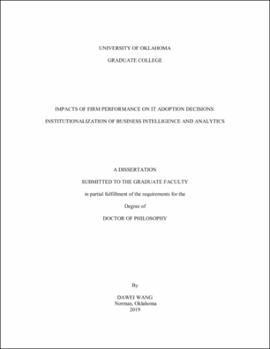| dc.description.abstract | IT innovations are key to public firms’ competitive advantage, even survival. We investigated the diffusion of a novel IT innovation – Business Intelligence and Analytics (BI&A) from a performance feedback perspective. We examined how decision-makers of underperforming firms engage with BI&A in response to performance shortfalls relative to aspirations. This important antecedent from the performance feedback perspective has been overlooked in IT innovation diffusion literature. Drawing upon Behavioral Theory of the Firm (BTOF), Strategic Reference Point Theory (SRPT), and social comparison theory (SCT), we argue that firms’ performance relative to historical and social aspirations is a salient antecedent in firms’ decisions to engage with IT innovations. Specifically, we hypothesize that radicalness of BI&A that firms engage with is driven more by social aspiration gap than by historical aspiration gaps; diversity of BI&A is driven more by historical aspiration gap than by social aspiration gaps. In addition, we examine the potential decoupling issue and argue that social aspiration gaps have stronger impacts on informational and material engagement than do material engagement; social aspiration gaps have stronger impacts on informational engagement than on material engagement. Using an institutionalization framework, we also argue that the relationships are stronger in the early BI&A diffusion stage than in the later diffusion stage. We use data from multiple archival sources (CITDB, COMPUSTAT, EDGAR, ABI/INFORM, FACTIVA, CONGRESS.GOV, etc.), to develop a longitudinal sample of 3,311 firm-year observations between 2010 and 2015. Our hypotheses are generally supported. In particular, we found that underperforming firms tend to engage with more radical BI&A; we did not observe the diversity of BI&A is driven by either historical or social aspirations. Regarding decoupling, we found that social aspiration gaps do not exert significantly higher impacts on firms’ engagement with BI&A than do historical aspirations. Instead, contrary to our prediction that informational engagement with BI&A reacts more to performance shortfalls relative to social aspiration gaps than would material engagement, we found that materially engaging with BI&A matter more to decision makers, extending the decoupling research – i.e., firms commit to the use of BI&A (doing things) rather than announcing it (saying). Regarding institutionalization of BI&A, we observed that these relationships between performance shortfalls and BI&A diffusion patterning are stronger in the early BI&A diffusion stage than in later BI&A diffusion stage. | en_US |
